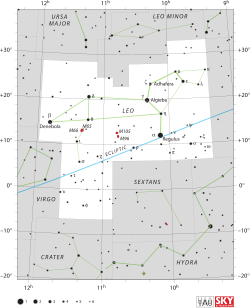HVS 7
| HVS 7 | |
 | |
| Observationsdata Epok: J2000.0 | |
|---|---|
| Stjärnbild | Lejonet |
| Rektascension | 11t 33m 12,125 s[1] |
| Deklination | +01° 08′ 24,87 ″[1] |
| Skenbar magnitud () | +17,80[2] |
| Stjärntyp | |
| Spektraltyp | sdB[3] |
| Astrometri | |
| Radialhastighet () | +518[4] km/s |
| Egenrörelse (µ) | RA: -1[5] mas/år Dek.: 1[5] mas/år |
| Parallax () | 0,0696 ± 0,1402[6] |
| Avstånd | 180 000 lå (55 000[7] pc) |
| Detaljer | |
| Massa | 3,7[8] M☉ |
| Radie | 4,0[8] R☉ |
| Luminositet | 300[8] L☉ |
| Temperatur | 12 000[8] K |
| Vinkelhastighet | 55[8] km/s |
| Ålder | 150[8] miljoner år |
| Andra beteckningar | |
| SDSS J113312.12+010824.8, SDSS J113312.12+010824.9, USNO-A2.0 0900-06954189, Gaia DR2 3799146650623432704, Gaia DR3 3799146650623432704, EPIC 201540171[6] | |
HVS 7 -- hyper-velocity star 7, eller SDSS J113312.12+010824.9, är en ensam stjärna i södra delen av stjärnbilden Lejonet. Den har en skenbar magnitud av ca 17,80[2] och kräver ett mycket kraftfullt teleskop för att kunna observeras. Stjärnan beräknas den befinna sig på ett avstånd på ca 180 000 ljusår (ca 55 000 parsek) [7] från solen. Den rör sig bort från solen med en heliocentrisk radialhastighet på 518 km/s.[4]
Egenskaper
HVS 7 är en vit till blå dvärgstjärna av spektralklass sdB.[3] Den har en massa som är ca 3,7[8] solmassor, en radie som är ca 4[8] solradier och har ca 300[8] gånger solens utstrålning av energi från dess fotosfär vid en effektiv temperatur av ca 12 000 K.[8]
HVS 7 är en sällsynt stjärna som har accelererats till en rörelse snabbare än Vintergatans flykthastighet.[8][9] År 2013 skrev ett team under N. Przybilla att stjärnan hade en kemiskt ovanlig fotosfär, som maskerade dess ursprung.[8] Stjärnan katalogiserades först under Sloan Digital Sky Survey. Den identifierades som en stjärna med hög hastighet 2006.[9]
Stjärnan har ett kemiskt säreget spektrum liknande en subdvärg av spektraltyp B. Stjärnor i denna region av Hertzsprung–Russell-diagrammet förväntas antingen vara varma stjärnor på horisontella jättegrenen, objekt med heliumfusion med låg massa eller stjärnor med vätefusion med måttlig massa något under huvudserien. Den höga rotationshastigheten för HVS 7 betyder att det sannolikt är en ung stjärna nära huvudserien, cirka 150 miljoner år gammal och har 3,7 gånger solens massa.[8]
Referenser
- Den här artikeln är helt eller delvis baserad på material från engelskspråkiga Wikipedia, HVS 7, 23 november 2022.
Noter
- ^ [a b] Adelman-McCarthy, Jennifer K. (2008). "The Sixth Data Release of the Sloan Digital Sky Survey". The Astrophysical Journal Supplement Series. 175 (2): 297–313. arXiv:0707.3413. Bibcode:2008ApJS..175..297A. doi:10.1086/524984. S2CID 7699771.
- ^ [a b] Brown, Warren R.; Geller, Margaret J.; Kenyon, Scott J.; Kurtz, Michael J.; Bromley, Benjamin C. (2007). "Hypervelocity Stars. III. The Space Density and Ejection History of Main-Sequence Stars from the Galactic Center". The Astrophysical Journal. 671 (2): 1708. arXiv:0709.1471. Bibcode:2007ApJ...671.1708B. doi:10.1086/523642. S2CID 15074398.
- ^ [a b] Harris, Hugh C.; Liebert, James; Kleinman, S. J.; Nitta, Atsuko; Anderson, Scott F.; Knapp, Gillian R.; Krzesiński, Jurek; Schmidt, Gary; Strauss, Michael A.; Vanden Berk, Dan; Eisenstein, Daniel; Hawley, Suzanne; Margon, Bruce; Munn, Jeffrey A.; Silvestri, Nicole M.; Smith, J. Allyn; Szkody, Paula; Collinge, Matthew J.; Dahn, Conard C.; Fan, Xiaohui; Hall, Patrick B.; Schneider, Donald P.; Brinkmann, J.; Burles, Scott; Gunn, James E.; Hennessy, Gregory S.; Hindsley, Robert; Ivezić, Zeljko; Kent, Stephen; et al. (2003). "An Initial Survey of White Dwarfs in the Sloan Digital Sky Survey". The Astronomical Journal. 126 (2): 1023. arXiv:astro-ph/0305347. Bibcode:2003AJ....126.1023H. doi:10.1086/376842. S2CID 118927660.
- ^ [a b] Adelman-Mccarthy, J. K.; et al. (2011). "VizieR Online Data Catalog: The SDSS Photometric Catalog, Release 8 (Adelman-McCarthy+, 2011)". VizieR On-line Data Catalog. Bibcode:2011yCat.2306....0A.
- ^ [a b] Brown, A. G. A.; et al. (Gaia collaboration) (August 2018). "Gaia Data Release 2: Summary of the contents and survey properties". Astronomy & Astrophysics. 616. A1. arXiv:1804.09365. Bibcode:2018A&A...616A...1G. doi:10.1051/0004-6361/201833051. Gaia DR2 record for this source at VizieR.
- ^ [a b] EPIC 201540171 (unistra.fr). Hämtad 2023-05-31.
- ^ [a b] Brown, Warren R. (2006). "Hypervelocity Stars. I. The Spectroscopic Survey". The Astrophysical Journal. 647 (1): 303–311. arXiv:astro-ph/0604111. Bibcode:2006ApJ...647..303B. doi:10.1086/505165. S2CID 15561164.
- ^ [a b c d e f g h i j k l m] Przybilla, N.; Nieva, M. F.; Tillich, A.; Heber, U.; Butler, K.; Brown, W. R. (2008). "HVS 7: A chemically peculiar hyper-velocity star". Astronomy & Astrophysics. 488 (2): L51–L54. arXiv:0810.0864. Bibcode:2008A&A...488L..51P. doi:10.1051/0004-6361:200810455. S2CID 56111543. Such a surface abundance pattern is caused by atomic diffusion in a possibly magnetically stabilised, non-convective atmosphere. Hence all chemical information on the star's place of birth and its evolution has been washed out. High precision astrometry is the only means to validate a GC origin for HVS 7.
- ^ [a b] Brown, Warren R.; Geller, Margaret J.; Kenyon, Scott J.; Kurtz, Michael J. (2006). "Hypervelocity Stars. I. The Spectroscopic Survey". The Astrophysical Journal. 647 (1): 303–311. arXiv:astro-ph/0604111. Bibcode:2006ApJ...647..303B. doi:10.1086/505165. S2CID 15561164. Here we report the two most recently discovered HVSs: SDSS J110557.45+093439.5 and possibly SDSS J113312.12+010824, traveling with Galactic rest-frame velocities at least +508+/-12 and +418+/-10 km s-1, respectively.














